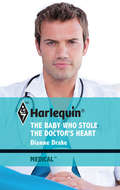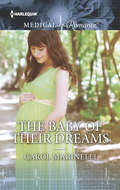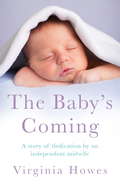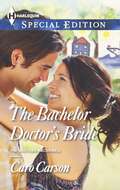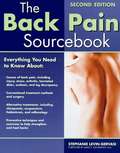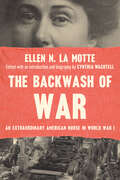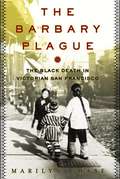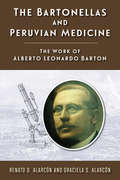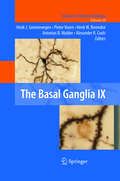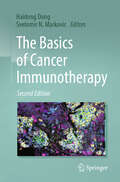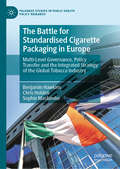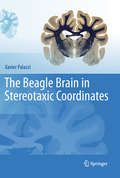- Table View
- List View
The Baby Who Stole the Doctor's Heart (Mountain Village Hospital #4)
by Dianne DrakeThere's no place in brooding Dr. Mark Anderson's life for love. He's working temporarily in White Elk as a favor, then he'll be gone-and nothing will make him look back.Until he meets beautiful single mom Angela and her adorable daughter. The last thing this rugged doctor expected was to lose his heart to these two, but the moment Angela's baby girl utters her first word-Daddy-he's wrapped around her chubby little finger!The time has come for Mark to move on...but now he's looking for a permanent role-as part of their little family!
The Baby of Their Dreams
by Carol MarinelliBarcelona, baby...bride? Seven years ago ER doctor Cat Hayes was left heartbroken after losing her baby boy. Now she's focused on her career. But when she meets gorgeous Dr. Dominic Edwards at a Spanish conference, resisting his scorching touch isn't easy... Cat returns home sun-kissed and accidentally pregnant! Widower Dom never thought he'd ever find love again-let alone a family! As the promise of their miracle baby begins to heal both their hearts, Dom knows he can't let Cat slip through his fingers. All it takes is one down-on-one-knee question...
The Baby's Coming: A Story of Dedication by an Independent Midwife
by Virginia HowesVirginia Howes was a mother of four doing the ironing when she had a revelation. Still broody, but not really wanting to add to her family, she realised that becoming a midwife was her true vocation.It was a long journey to get the education and qualifications she needed, especially with a young family, but she was determined and never doubted her decision. Following her training, she spent three years working within the NHS, but her naturally independent spirit fought against the constraints of the system and twelve years ago she decided to set up on her own. Virginia works with mothers who want to give birth at home naturally, something which Virginia believes in passionately. 350 births later, Virginia still loves what she does.The Baby's Coming> is Virginia's memoir and tells the stories of her training as a midwife as well as some of the most memorable of those 350 births: the most dramatic, the most touching. Virginia particularly remembers the births of her own grandchildren whose arrivals in the world were some of the most special moments for her as both a midwife and grandmother.
The Baby's Coming: A Story of Dedication by an Independent Midwife
by Virginia HowesVirginia Howes was a mother of four doing the ironing when she had a revelation. Still broody, but not really wanting to add to her family, she realised that becoming a midwife was her true vocation.It was a long journey to get the education and qualifications she needed, especially with a young family, but she was determined and never doubted her decision. Following her training, she spent three years working within the NHS, but her naturally independent spirit fought against the constraints of the system and twelve years ago she decided to set up on her own. Virginia works with mothers who want to give birth at home naturally, something which Virginia believes in passionately. 350 births later, Virginia still loves what she does.The Baby's Coming> is Virginia's memoir and tells the stories of her training as a midwife as well as some of the most memorable of those 350 births: the most dramatic, the most touching. Virginia particularly remembers the births of her own grandchildren whose arrivals in the world were some of the most special moments for her as both a midwife and grandmother.
The Bachelor Doctor's Bride (The Doctors MacDowell #3)
by Caro CarsonPaging Dr. Love! Cardiologist Quinn MacDowell has no time for affairs of the heart-especially those not related to his job. So when bubbly Diana Connor gets underneath his white coat like no woman has before, Quinn is determined to keep his hands, and his heart, to himself. She's just too...well, peppy...for a man as serious as him. Or so he keeps telling himself... No matter how hard she tries, Diana just can't seem to break through Quinn's icy facade. The hunky doctor must want someone who doesn't come with all of her baggage. But then these polar opposites find themselves working side by side, and both are hit by Cupid's arrow-for which there's no cure!
The Back Pain Sourcebook: Everything You Need to Know
by Stephanie Levin-GervasiThe Back Pain Sourcebook is a complete guide for the back pain sufferer, offering information on why backs hurt and what people can do to relieve the pain, including the latest treatments and medications. This updated edition includes expanded information on problems such as herniated disks, bone spurs, back sprains, arthritis pain, tumors, and infections. The book explains preventive techniques and exercises to help strengthen and heal bad backs and presents alternative healing methods such as Rolfing, shiatsu, acupuncture, yoga, Mensendieck, Feldenkrais, and reflexology.
The Backwash of War: An Extraordinary American Nurse in World War I
by Ellen N. La MotteBanned in multiple countries for its frank depiction of the horrors of war, Ellen N. La Motte's The Backwash of War is one of the most stunning antiwar books ever published."We are witnessing a phase in the evolution of humanity, a phase called War—and the slow, onward progress stirs up the slime in the shallows, and this is the Backwash of War. It is very ugly."—Ellen N. La MotteIn September 1916, as World War I advanced into a third deadly year, an American woman named Ellen N. La Motte published a collection of stories about her experience as a war nurse. Deemed damaging to morale, The Backwash of War was immediately banned in both England and France and later censored in wartime America. At once deeply unsettling and darkly humorous, this compelling book presents a unique view of the destruction wrought by war to the human body and spirit. Long neglected, it is an astounding book by an extraordinary woman and merits a place among major works of WWI literature. This volume gathers, for the first time, La Motte's published writing about the First World War. In addition to Backwash, it includes three long-forgotten essays. Annotated for a modern audience, the book features both a comprehensive introduction to La Motte's war-time writing in its historical and literary contexts and the first extended biography of the "lost" author of this "lost classic." Not only did La Motte boldly breach decorum in writing The Backwash of War, but she also forcefully challenged societal norms in other equally remarkable ways, as a debutante turned Johns Hopkins–trained nurse, pathbreaking public health advocate and administrator, suffragette, journalist, writer, lesbian, and self-proclaimed anarchist.
The Bad Food Bible: Why You Can (and Maybe Should) Eat Everything You Thought You Couldn't
by Aaron CarrollPhysician and popular New York Times contributor Aaron Carroll mines the latest evidence to show that many &“bad&” ingredients actually aren&’t unhealthy, and in some cases are essential to our well-being.Advice about food can be confusing. There&’s usually only one thing experts can agree on: some ingredients—often the most enjoyable ones—are bad for you, full stop. But as Aaron Carroll explains, if we stop consuming some of our most demonized foods, it may actually hurt us. Examining troves of studies on dietary health, Carroll separates hard truths from hype, showing that you can Eat red meat several times a week. Its effects are negligible for most people, and actually positive if you&’re 65 or older.Have a drink or two a day. In moderation, alcohol may protect you against cardiovascular disease without much risk.Enjoy a gluten-loaded bagel from time to time. It has less fat and sugar, fewer calories, and more fiber than a gluten-free one.Eat more salt. If your blood pressure is normal, you may be getting too little sodium, not too much. Full of counterintuitive, deeply researched lessons about food we hate to love, The Bad Food Bible is for anyone who wants to forge eating habits that are sensible, sustainable, and occasionally indulgent.
The Balance Within: The Science Connecting Health and Emotions
by Esther M. Sternberg“A dazzling tour of a most promising area of neuroscience—the interface between the immune system and the nervous system.” —Elliot S. Gershon, MD, Professor of Psychiatry, The University of ChicagoSince ancient times humans have felt intuitively that emotions and health are linked, and recently there has been much popular speculation about this notion. But until now, without compelling evidence, it has been impossible to say for sure that such a connection really exists and especially how it works.Now, that evidence has been discovered.In this beautifully written book, Dr. Esther Sternberg, whose discoveries were pivotal in helping to solve this mystery, provides firsthand accounts of the breakthrough experiments that revealed the physical mechanisms—the nerves, cells, and hormones—used by the brain and immune system to communicate with each other. She describes just how stress can make us more susceptible to all types of illnesses, and how the immune system can alter our moods. Finally, she explains how our understanding of these connections in scientific terms is helping to answer such crucial questions as “Does stress make you sick?” “Is a positive outlook the key to better health?” and “How do our personal relationships, work, and other aspects of our lives affect our health?”A fascinating, elegantly written portrait of this rapidly emerging field with enormous potential for finding new ways to treat disease and cope with stress, The Balance Within is essential reading for anyone interested in making their body and mind whole again.“Dr. Sternberg weaves historical perspective, recent lab results, academic rigor and popular appeal into an engrossing book.” —The Dallas Morning News
The Balanced Body: A Guide to Deep Tissue and Neuromuscular Therapy (3rd edition)
by Donald W. ScheumannThe Balanced Body provides a systematic training program for deep tissue and neuromuscular therapy, and other massage modalities.
The Barbary Plague
by Marilyn Chase"San Francisco in 1900 was a Gold Rush boomtown settling into a gaudy middle age. . . . It had a pompous new skyline with skyscrapers nearly twenty stories tall, grand hotels, and Victorian mansions on Nob Hill. . . . The wharf bristled with masts and smokestacks from as many as a thousand sailing ships and steamers arriving each year. . . . But the harbor would not be safe for long. Across the Pacific came an unexpected import, bubonic plague. Sailing from China and Hawaii into the unbridged arms of the Golden Gate, it arrived aboard vessels bearing rich cargoes, hopeful immigrants, and infected vermin. The rats slipped out of their shadowy holds, scuttled down the rigging, and alighted on the wharf. Uphill they scurried, insinuating themselves into the heart of the city."The plague first sailed into San Francisco on the steamer Australia, on the day after New Year's in 1900. Though the ship passed inspection, some of her stowaways--infected rats--escaped detection and made their way into the city's sewer system. Two months later, the first human case of bubonic plague surfaced in Chinatown. Initially in charge of the government's response was Quarantine Officer Dr. Joseph Kinyoun. An intellectually astute but autocratic scientist, Kinyoun lacked the diplomatic skill to manage the public health crisis successfully. He correctly diagnosed the plague, but because of his quarantine efforts, he was branded an alarmist and a racist, and was forced from his post. When a second epidemic erupted five years later, the more self-possessed and charming Dr. Rupert Blue was placed in command. He won the trust of San Franciscans by shifting the government's attack on the plague from the cool remove of the laboratory onto the streets, among the people it affected. Blue preached sanitation to contain the disease, but it was only when he focused his attack on the newly discovered source of the plague, infected rats and their fleas, that he finally eradicated it--truly one of the great, if little known, triumphs in American public health history.With stunning narrative immediacy fortified by rich research, Marilyn Chase transports us to the city during the late Victorian age--a roiling melting pot of races and cultures that, nearly destroyed by an earthquake, was reborn, thanks in no small part to Rupert Blue and his motley band of pied pipers.From the Hardcover edition.
The Barbary Plague: The Black Death in Victorian San Francisco
by Marilyn ChaseThe plague began in North America in 1900 when it arrived in San Francisco. The history of the city, the story of individuals dedicated to saving lives and the Great Earthquake are all here.
The Bartonellas and Peruvian Medicine: The Work of Alberto Leonardo Barton (Rutgers Global Health)
by Graciela S Alarcón Renato D AlarcónThe Bartonellas and Peruvian Medicine explores the events surrounding the discovery of the etio-pathogenic agent of the Oroya Fever, also known as Peruvian Verruga or Carrión’s disease (an endemic infectious disease in South America’s Andean regions) by Dr. Alberto Leonardo Barton. Graciela S. Alarcón and Renato D. Alarcón recount Barton’s persistent work against skepticism, obstacles, and limitations imposed by members of Peru’s medical elites of the time, as well as his eventual successful scientific career and the delayed but well-deserved global recognition of his contributions. The book is the result of intense bibliographic research and of original documents aimed not just at the examination of Barton’s life and work, but also the examination of today’s perspectives and future work in the field of infectious and “neglected” diseases. The authors address current scientific information on the relevant bacteria Bartonella bacilliformis, besides current research and clinical status of the other Bartonellas, making it a useful and practical text for those studying infectious diseases.
The Basal Ganglia IX
by Antonius B. Mulder Pieter Voorn Hendrik Jan Groenewegen Henk W. Berendse Alexander R. CoolsThe aim of the International Basal Ganglia Society (IBAGS) is to further our understanding of normal basal ganglia function and the pathophysiology of disorders of the basal ganglia, including Parkinson's disease, Huntington's disease, and schizophrenia. Each triennial meeting of IBAGS brings together basic research scientists from all disciplines as well as clinicians who are actively involved in the treatment of basal ganglia disorders, to discuss the most recent advances in the field and to generate new approaches and ideas for the future. This volume comprises the proceedings of the 9th meeting of IBAGS, held in Egmond aan Zee, The Netherlands, September 2nd-6th, 2007.
The Basic Principles of External Skeletal Fixation Using the Ilizarov and Other Devices
by Leonid SolominThe Ilizarov device has revolutionized the treatment of non-healing fractures and the correction of deformities. This book supplies all the information required in order to use the Ilizarov and other external fixation devices optimally; it will serve as an indispensable manual for both trainee and experienced orthopedic surgeons. Biomechanical principles, preoperative preparation, and the use of a system of coordinates to allow safer insertion of K-wires and half pins are thoroughly discussed. External fixation of a variety of fractures in different pathologic settings is then clearly explained in a series of detailed chapters with the aid of high-quality illustrations. Numerous case reports are included to illustrate the results of different treatment methods. In addition, postoperative management and treatment of complications are described. Since the first edition the text has been thoroughly updated, with inclusion of contributions from leading world experts.
The Basic Principles of External Skeletal Fixation Using the Ilizarov and Other Devices
by Leonid SolominThe Ilizarov device has revolutionized the treatment of non-healing fractures and the correction of deformities. This book supplies all the information required in order to use the Ilizarov and other external fixation devices optimally; it will serve as an indispensable manual for both trainee and experienced orthopedic surgeons. Biomechanical principles, preoperative preparation, and the use of a system of coordinates to allow safer insertion of K-wires and half pins are thoroughly discussed. External fixation of a variety of fractures in different pathologic settings is then clearly explained in a series of detailed chapters with the aid of high-quality illustrations. Numerous case reports are included to illustrate the results of different treatment methods. In addition, postoperative management and treatment of complications are described. Since the first edition the text has been thoroughly updated, with inclusion of contributions from leading world experts.
The Basics Of Reiki: A Step-By-Step Guide to Reiki Practice
by Penelope QuestThe Basics of Reiki by Penelope Quest offers a clear and accessible introduction to an increasingly popular and powerful healing art. Best known as a gentle hands-on-healing technique for physical ailments, Reiki is also a holistic system which can be used for healing body, mind, emotions and spirit. In this helpful and easy-to-follow book, you will discover everything you need to know, including: the origins and development of Reiki as a healing system; what to expect when receiving a Reiki treatment; how Reiki treats both the symptoms and the causes of illness, easing physical pain and helping to clear emotional blockages; how easily you can be attuned to Reiki, and what to expect at each level of training; how to use Reiki for self-healing and for healing other people, animals, plants and the environment; practical exercises and visualisations to encourage relaxation and develop insight and energy awareness. This is the perfect choice for those who want to find out more about Reiki and the benefits it can offer, from a highly qualified and experienced Reiki Master.
The Basics Of Reiki: A step-by-step guide to reiki practice
by Penelope QuestThe Basics of Reiki by Penelope Quest offers a clear and accessible introduction to an increasingly popular and powerful healing art. Best known as a gentle hands-on-healing technique for physical ailments, Reiki is also a holistic system which can be used for healing body, mind, emotions and spirit. In this helpful and easy-to-follow book, you will discover everything you need to know, including: the origins and development of Reiki as a healing system; what to expect when receiving a Reiki treatment; how Reiki treats both the symptoms and the causes of illness, easing physical pain and helping to clear emotional blockages; how easily you can be attuned to Reiki, and what to expect at each level of training; how to use Reiki for self-healing and for healing other people, animals, plants and the environment; practical exercises and visualisations to encourage relaxation and develop insight and energy awareness. This is the perfect choice for those who want to find out more about Reiki and the benefits it can offer, from a highly qualified and experienced Reiki Master.
The Basics of Cancer Immunotherapy
by Haidong Dong Svetomir N. MarkovicThis comprehensively updated new edition provides patients and their physicians (especially non-oncologist healthcare providers) with a clear and concise introduction to cancer immunotherapy. Unlike traditional forms of cancer therapy, immunotherapy acts by boosting the patient’s own immune system to fight cancer; immunotherapy's unique features make its management, monitoring and side-effects different from those of traditional cancer therapy. Especially novel are the side effects of cancer immunotherapy, necessitating greater awareness for both patients and physicians in order to minimize complications and maximize benefits. The patient-friendly and state-of-the-art knowledge presented in this book will inform patients and their care providers about the benefits and risks of cancer immunotherapy, and help them to understand how immunotherapy would control their unique disease. Researchers and academic professionals in the field of cancer immunotherapy will also find clear, useful information to help them communicate with patients and address unresolved issues. Key features include: Expertise. Editors and authors are scientists and oncologists specializing in cancer immunotherapy, involved in scientific discovery from the early stage of immune-checkpoint inhibitors to today's patient care. Their insights, expertise and experience guarantee high quality and authority in the science, medicine and practice of cancer immunotherapy. Patient-friendly. This book is written specifically for cancer patients considering or undergoing immunotherapy. As an educational tool, this book will help the reader to understand the underlying science, balance the risks and benefits based on both research and clinical facts, and make an informed decision regarding their treatment options. Disease Specificity. Cancer is a complicated disease involving multiple stages and pathology. Its response to immunotherapy is individualized and varies depending on cancer types. The authors’ expertise in treating different types of cancers, including melanoma, lung, kidney, bladder, breast, and lymphoma, provides disease-specific insights in applying immunotherapy to each disease. State-of-the-Art. This edition has been comprehensively updated to reflect recent advances, including detailed coverage of the latest therapies like CAR-T, TIL, immune checkpoint inhibitors and bispecific T cell engaging antibodies, and dedicated chapters on breast cancer, solid organ transplant recipients, GI and genitourinary malignancies, and resistant cancer. Aimed at patients and non-oncologist care providers as a resource when seeking immunotherapy as a treatment option Detailed focus on various cancers provides disease-specific insights, clinical studies, and risk/benefit analysis Comprehensively updated to address the latest immunotherapies and expanded coverage of disease-specific scenarios
The Basics of Molecular Biology
by Alexander VologodskiiAccessible and comprehensive, this book describes the universal cellular nature of living organisms and is an indispensable tool for anyone in the sciences who wishes to get a quick overview of molecular biology. Individual chapters cover nucleic acids and proteins, genetic code and protein synthesis, the fidelity of transferring genetic information to the next generations, and the regulation of various processes inside the cells. Special attention is paid to new areas rising from modern DNA sequencing technologies which transform biology. The book also touches on developing areas, such as cures for cancer and CRISPR, which are important for medicine and the future of humankind.
The Basics of Process Mapping
by Robert DamelioThis book provides how-to guidance and examples for three types of maps, namely relationship map, cross-functional process map, and flowchart. It helps readers to effectively apply all three types of maps to make work visible at the organization, process, and job/performer levels.
The Basics: A Comprehensive Outline of Nursing School Content (Kaplan Test Prep)
by Kaplan NursingKaplan&’s The Basics provides comprehensive review of essential nursing school content so you can ace your assignments and exams. The Best Review All the essential content you need, presented in outline format and easy-access tables for efficient reviewChapters mirror the content covered in your nursing school curriculum so you know you have complete content coverageUsed by thousands of students each year to succeed in nursing school and beyondExpert GuidanceKaplan&’s expert nursing faculty reviews and updates content annuallyWe invented test prep—Kaplan (www.kaptest.com) has been helping students for 80 years. Our proven strategies have helped legions of students achieve their dreams.
The Battle for Standardised Cigarette Packaging in Europe: Multi-Level Governance, Policy Transfer and the Integrated Strategy of the Global Tobacco Industry (Palgrave Studies in Public Health Policy Research)
by Chris Holden Benjamin Hawkins Sophie Mackinder"This book is essential reading for researchers of tobacco policy change. Too many studies simply complain that change is too slow because tobacco companies are too powerful and politicians lack the will to challenge them. This book goes much further, to help us understand not just industry strategy but the policy processes in which policy advocates engage, learn from each other, and help create essential global tobacco policy change."Paul Cairney, University of Stirling, UK"This book is rare in making genuinely significant contributions across both public health and policy studies. By focusing on the battle for standardised packs, it engagingly addresses one of the most prominent recent innovations in health policy that has relevance both beyond Europe and across multiple spheres of health policy. In doing so, it also offers an innovative analysis of the role of transnational corporations in policy transfer."Jeff Collin, University of Edinburgh, UKThis book analyses the battle for standardised cigarette packaging (‘plain packaging’) in Europe, drawing on the concepts of multi-level governance and policy transfer. It analyses the strategies of policy makers, non-governmental organisations and transnational tobacco companies in attempting either to advance or to block the introduction of standardised packaging. Taking a global and multi-level approach, it analyses these struggles within European Union institutions, EU member states, and across jurisdictions, as NGOs and tobacco companies worked transnationally to counter each other. As well as presenting original empirical research detailing these policy battles, the book provides new theoretical insights into policy transfer processes, particularly within multi-level polities, showing how transnational corporations can have dramatic effects on these processes. The book will appeal equally to public health researchers, policy analysts and political scientists.
The Battle for Veterans’ Healthcare: Dispatches from the Front Lines of Policy Making and Patient Care
by Suzanne GordonIn The Battle for Veterans' Healthcare, award-winning author Suzanne Gordon takes us to the front lines of federal policymaking and healthcare delivery, as it affects eight million Americans whose military service makes them eligible for Veterans Health Administration (VHA) coverage.Gordon’s collected dispatches provide insight and information too often missing from mainstream media reporting on the VHA and from Capitol Hill debates about its future. Drawing on interviews with veterans and their families, VHA staff and administrators, health care policy experts and Congressional decision makers, Gordon describes a federal agency under siege that nevertheless accomplishes its difficult mission of serving men and women injured, in myriad ways, while on active duty.The Battle for Veterans’ Healthcare is an essential primer on VHA care and a call to action by veterans, their advocacy organizations, and political allies. Without lobbying efforts and broader public understanding of what’s at stake, a system now functioning far better than most private hospital systems may end up looking more like them, to the detriment of patients and providers alike.
The Beagle Brain in Stereotaxic Coordinates
by Xavier PalazziThis is an up-to-date atlas of the stereotaxic coordinates of the beagle brain. It provides stellar illustrations of the organization of nerve tracts and the morphology of the nuclei that compose the central nervous system.
